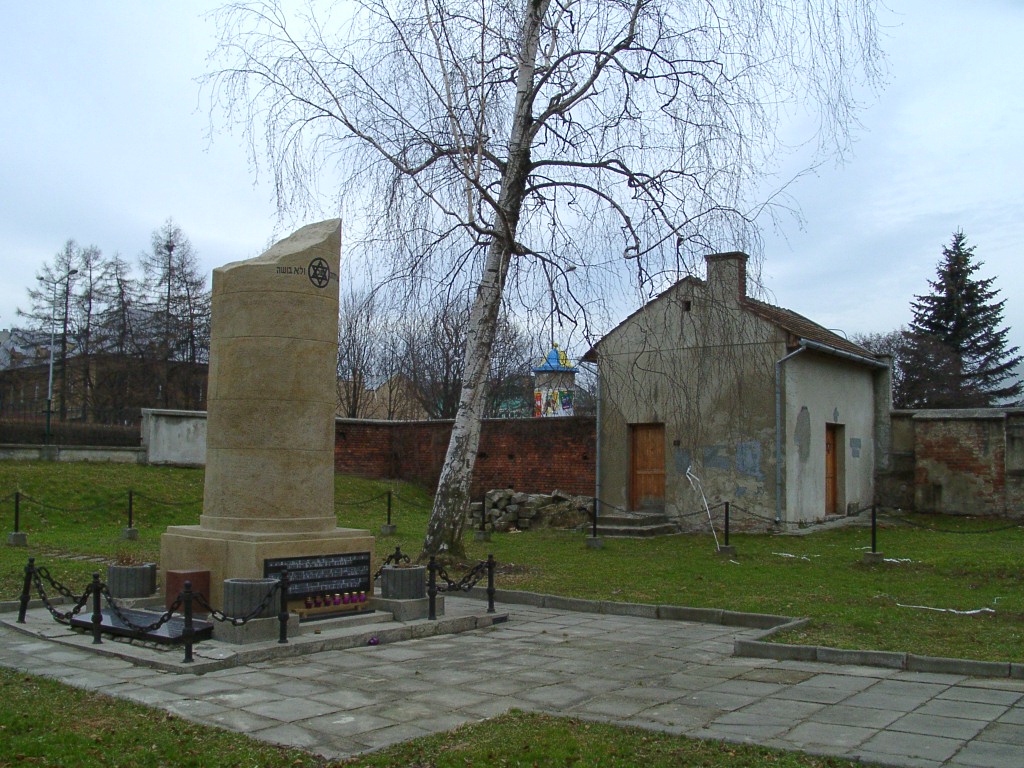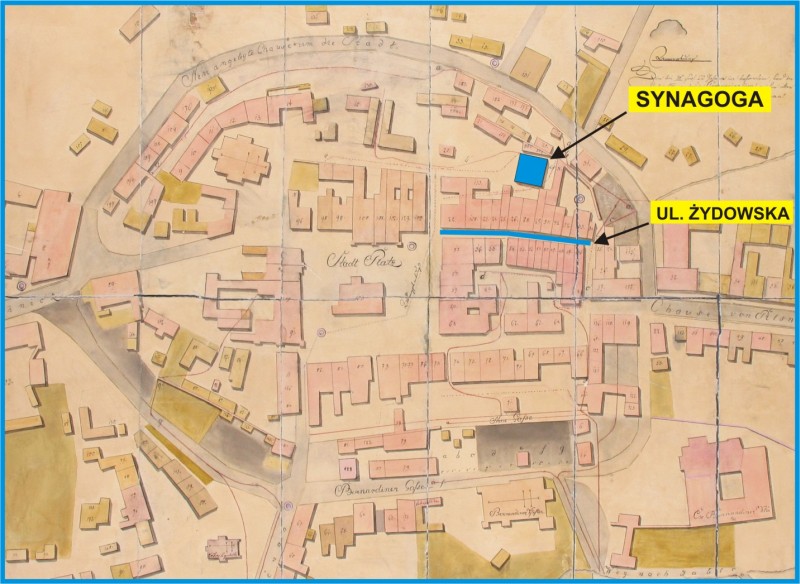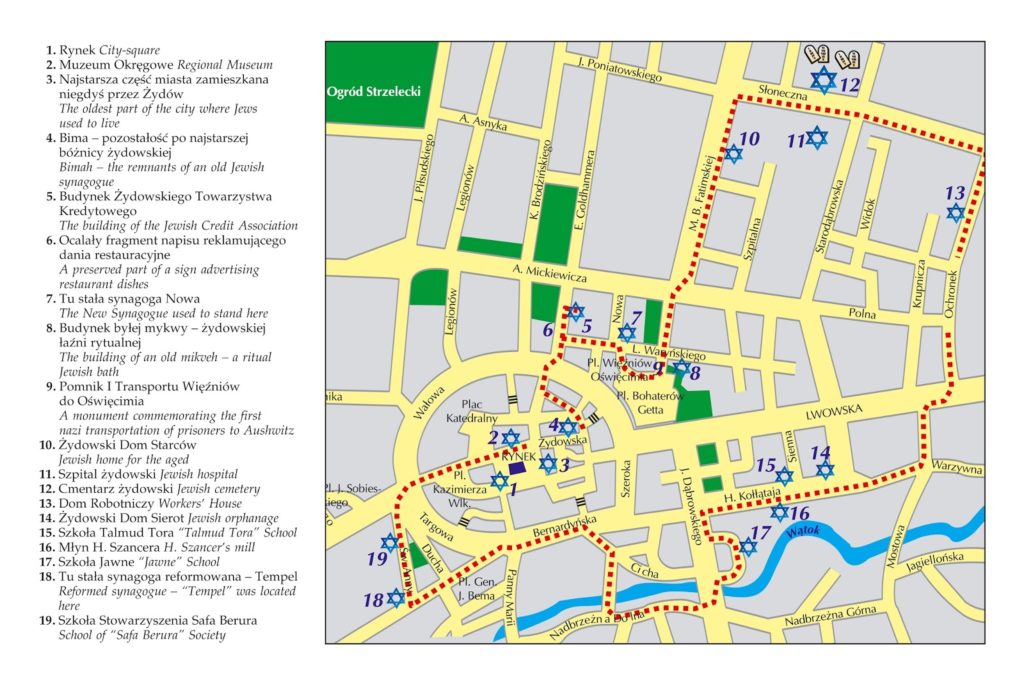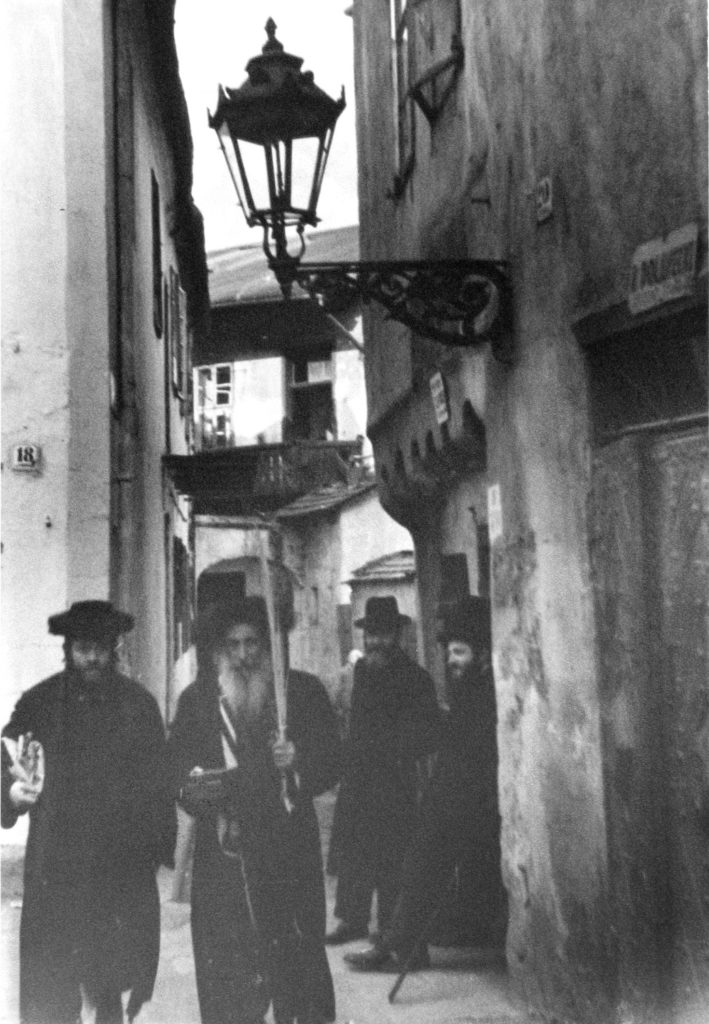 |
| The bima, remains of the Oldd Synagogue, destroyed in 1939 |
Implementing the Mezuzah project, which is of an educational character, it should be noted how the town Tarnów once was, when Jews that lived here since the end of nineteenth century, constituted almost half the population of this town.
For the Jewish Tarnów was economic power. Some of the industries or branches of craftsmanship as a whole were dominated by Jews. Also, most of the houses on the main streets of the city belonged to them. Nearly 90% of the houses in the streets: Wałowa, Bernardyńska, Brodzińskiego, Goldhammer, Nowa, Szpitalna, Koszarowa, Szeroka, Burku – these were Jewish houses. Almost 100% Jewish streets were: Lwowska, Żydowska, Wekslarska. The Jews were the owners of more than 80% of stores. Their participation in enterprises shaped, depending on the industry, from 50 to 90%. In areas such as: shoe upper makings, glass industry, furrier – there were no Christians.
Until World War I, Tarnów was the largest in the Austro-Hungarian hat-production center entirely dominated by the Jewish manufacturers. Felt for hats was made by labels such as Meira Zylbersztajn, Herman Klajn as well as Kinberg and Wajs. Thousands of their products were exported to Balkan countries. Even after the war the industry still employed over 600 people.
Tarnów was the Jewish clothing industry, which in the twenties consisted of more than 60 companies. For clarity, it should be added that amongst them there were small establishments employing just a few people, including the owners’ families. Among these establishments there were 32 tailoring companies, 5 women’s clothing, 10 hat making, 7 lingerie, 3 corsetry.
The garment industry, the pride of the Jewish industry in Tarnów had a rich history in the beginning of which is Rajzla Rubin. In the mid-nineteenth century she dealt with the purchase of old clothes, which eventually started to bring them from Budapest herself. Around 1860, she herself started to sew Zeug trousers and jackets, selling them wholesale. Employing a number of sons and sons-in-law, this resourceful woman organized a developed industry in half a century, employing hundreds of peoplebefore1939.
Companies such as Zelig Faust, Markus, David Feld, A.L. Sztajner – reached with their goods the borders of the Austro-Hungarian monarchy. Before World War I a modern factory belonging to Shaul Brandsteatter was the first company in Tarnów on the markets of Serbia, Bulgaria and Turkey. This industry declined during the crisis of the early thirties. Number of enterprises in the town declined and most companies employed only 2-4 people. It was then that hat industry disappeared completely. Rebuilt in the following years, the clothing industry, before the outbreak of World War II employed more than 3,000 people, not counting the cottagers.
A lot of people in the field of science and culture, coming from Tarnów and the surrounding towns, grew up over the local dimension. Figure, little known among Christians and rather forgotten today,
Mordechai David Brandstaetter; a writer, poet, considered one of the fathers of modern Hebrew literature. During his life his works were translated into English, Russian, German and Yiddish. His grandson Roman Brandstaetter, is already known as a Polish poet, critic and translator.
Whence originated Leon Kelner professor of English Studies, famous in Vienna, Shakespeare interpreter. He wrote an encyclopaedia of Shakespeare and his textbooks were taught to students throughout Europe. After his death, the name of Kelner was given to one of the streets of Vienna. A Talmudist Joseph Engel was also known in the world. During his life he issued 20 volumes of interpretation of Scripture, and left to release another 90. Another prominent historian was Ignacy (Isaac) Schipper, professor of Judaic studies, economic history, the author of many, considered to this day, works of books and hundreds of articles. Another historian – to Salo Baron, known mainly in the United States as Chair of Columbia University in New York. He was succeeded by another Tarnovian Zwi Ankori (Wrobel). Adolf Rudnicki (Aaron Hirszhorn) – writer, prominent artists – Alexander Plutzer (painter), David Beker, Abba Fenichel, Henry Kerner (sculptors) also came from and lived here.
It was an important center of political life. Here were associates Theodor Herzl – Leon Kelner, Abraham Salz, Chaim Najger. Hence came haluce – founders of one of the first pioneer settlements in Palestine, Mahanaim village in Galilee (1898).
A socialist, then communist Karol Sobelson was not a very liked figure. When, however, as Karl Radek he became a close associate of Lenin and editor of the Truth and Izvestia (Prawda i Izwestia), people began to boast such a countryman.
Jewish Tarnów, however, first and foremost comprises of religious Jews. All shades and different forms of orthodoxy. From emancipated Zionists, who have to maintain ties with the rest of the Jewish community at least once a year on Yom Kippur visited a synagogue, through progressive Maskilim praying in a modern synagogue Tempel (Anna’s Street in Tarnów), to the casual religious Jews for whom the place of worship was a huge Nowa synagogue (Jubilee, named after Franz Joseph is situated in Nowa Street) and finally – probably they were the most numerous – the whole Hasidic crowd all shades and directions, followers of the tzaddikim in the whole territory of the Republic of Poland. Among the crowd Hasidims from Nowy Sącz and Bobowa naturally dominated. They were terribly conflicted with the Jews from Sadogóra. Minor groups prayed in little temples in Dzików, Bojanów, Ostrowiec, Bełz, Bielsko Biała and in other places, which are forgotten even in the memories.
It is impossible to describe in such an occurrence or to describe wider this former Jewish Tarnów. Let these few images be enough, as a sketch of that departed world. A world that after the destruction was mentioned by Abraham Chomet, the last chairman of the Jewish community in Tarnów, in Tel Aviv: Perhaps it was the only city in the Republic of Poland, where in the Town Council citizens of different nationalities and religions worked in peace and harmony for the common good. Just mention that the budget estimated for the years 1930 to 1931 was presented by the councilor Shlomo Goldberg. In this budget subsidies for the various cultural and social institutions for the amount of PLN 80 000 were established. This was 56% for Catholic institutions, 44% for Jews. At the same each ethnic group separately was left with the right to allocate these subsidies.
Could we imagine how these relations would have been arranged today – would it not be for the destruction of half of the community in Tarnów?
Adam Bartosz
See also:
• The project is co-financed from the funds of the EEA under the program „Citizens for Democracy” and the funds of the National Cultural Centre under the program Culture – Interventions 2015.
 |
| Jewish cemetery in Tarnów with monument: the remains of column from New Synanogue, destroyed ib 1939, phot. Adam Bartosz |
 |
| Galicianer Shtetl, concert under the bima, phot. Adam Bartosz |



